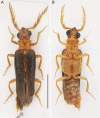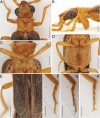Discovery of a new soft-bodied click-beetle genus from Namibia with a unique morphology leads to a modified diagnosis of Drilini (Coleoptera, Elateridae)
- PMID: 39372283
- PMCID: PMC11450458
- DOI: 10.3897/zookeys.1213.131283
Discovery of a new soft-bodied click-beetle genus from Namibia with a unique morphology leads to a modified diagnosis of Drilini (Coleoptera, Elateridae)
Abstract
Drilini are soft-bodied predatory click beetles with incompletely metamorphosed females. Approximately 150 described species are distributed in the Afrotropical, Palaearctic and Oriental realms, with the highest diversity known from sub-Saharan Africa. In this study, we describe Namibdrilusalbertalleni gen. et sp. nov. from Namibia which brings the total number of genera in Drilini to 16. The discovery of this unique taxon sheds new light on the diversity and evolution of the enigmatic paedomorphic beetle lineage and is interesting for several reasons. This new species is the only known representative of Drilini that has unidentate mandibles and lacks a hook on the dorsal part of the aedeagal median lobe, two of the few characters heretofore used for the unambiguous identification of members of this group. Furthermore, based on its morphology it belongs to a group of genera (Drilus clade) which heretofore contained only taxa from the Palaearctic Realm. We provide an updated diagnosis of the tribe Drilini, as well as an updated diagnosis and an identification key for the genera of the Drilus clade based on adult males. Further, we explain how to easily recognize adult Drilini from similar-looking soft-bodied elateroids like Elateridae: Omalisinae, Rhagophthalmidae, and Lampyridae: Ototretinae.
Keywords: Afrotropical Realm; Agrypninae; Elateroidea; click beetle; distribution; identification key; male genitalia; new genus; new species; paedomorphosis; taxonomy.
Robin Kundrata, Gabriela Packova.
Conflict of interest statement
The authors have declared that no competing interests exist.
Figures





Similar articles
-
New species of Selasia Laporte, 1838 (Elateridae: Agrypninae: Drilini) from Nepal and Pakistan.Zootaxa. 2017 Nov 7;4344(2):380-386. doi: 10.11646/zootaxa.4344.2.12. Zootaxa. 2017. PMID: 29245640
-
A review of Drilini (Coleoptera: Elateridae: Agrypninae) of the Northern Levant, with description of a new species from Syria and a key to Levantine species.Zootaxa. 2014 Jan 24;3755:457-69. doi: 10.11646/zootaxa.3755.5.5. Zootaxa. 2014. PMID: 24869833
-
Diversity of the Paedomorphic Snail-Eating Click-Beetle Genus Malacogaster Bassi, 1834 (Elateridae: Agrypninae: Drilini) in the Mediterranean.Biology (Basel). 2022 Oct 13;11(10):1503. doi: 10.3390/biology11101503. Biology (Basel). 2022. PMID: 36290407 Free PMC article.
-
Taxonomic review of Drilus Olivier, 1790 (Elateridae: Agrypninae: Drilini) from Asia Minor, with descriptions of seven new species and comments on the female antennal morphology in Drilini.Zootaxa. 2015 Sep 2;4012(1):78-96. doi: 10.11646/zootaxa.4012.1.4. Zootaxa. 2015. PMID: 26623846
-
Revised classification of the New World Cylapini (Heteroptera: Miridae: Cylapinae): taxonomic review of the genera Cylapinus, Cylapoides and Peltidocylapus and a morphology-based phylogenetic analysis of tribe Cylapini.Zootaxa. 2021 Dec 6;5074(1):1-66. doi: 10.11646/zootaxa.5074.1.1. Zootaxa. 2021. PMID: 35390841 Review.
References
-
- Baalbergen E, Helwerda R, Schelfhorst R, Castillo Cajas RF, van Moorsel CHM, Kundrata R, Welter-Schultes FW, Giokas S, Schilthuizen M. (2014) Predator-prey interactions between shell-boring beetle larvae and rock-dwelling land snails. PLoS ONE 9(6): e100366. 10.1371/journal.pone.0100366 - DOI - PMC - PubMed
-
- Bocek M, Fancello L, Motyka M, Bocakova M, Bocak L. (2018) The molecular phylogeny of Omalisidae (Coleoptera) defines the family limits and demonstrates low dispersal propensity and ancient vicariance patterns. Systematic Entomology 43: 250–261. 10.1111/syen.12271 - DOI
-
- Crowson RA. (1972) A review of the classification of Cantharoidea (Coleoptera), with definition of two new families, Cneoglossidae and Omethidae. Revista de la Universidad de Madrid 21: 35–77.
-
- Geisthardt M. (1977) Redeskription der weiblichen Imago von Homalisusfontisbellaquei Geoffroy 1762 (Coleoptera: Homalisidae). Mitteilungen des Internationalen Entomologischen Vereins e. V. 3: 113–119.
-
- Geisthardt M. (2007) Neue und bekannte Selasia Laporte, 1836 Arten aus dem südliche Afrika (Coleoptera, Drilidae). Entomologica Basiliensia et Collectionis Frey 29: 31–40.
LinkOut - more resources
Full Text Sources
